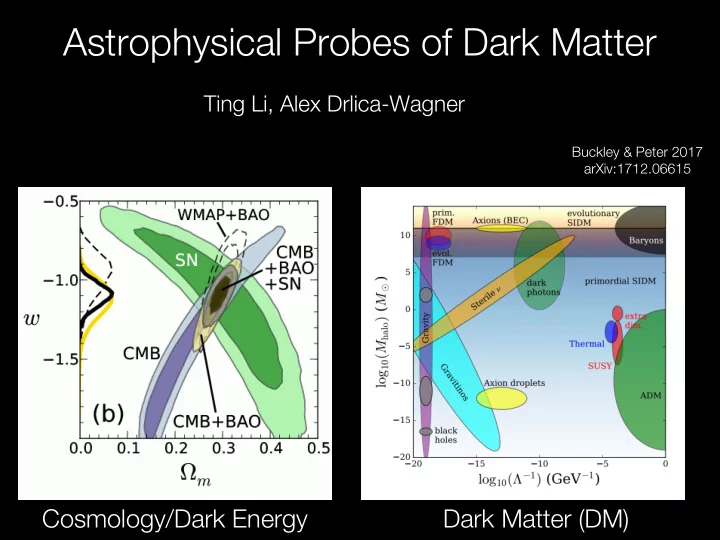

Astrophysical Probes of Dark Matter Ting Li, Alex Drlica-Wagner Buckley & Peter 2017 arXiv:1712.06615 Cosmology/Dark Energy Dark Matter (DM)
Orbital Motion in Galaxy M33 courtesy: Josh Frieman
The Hunt for Dark Matter e.g., LHC Particle mass set by the weak scale: Production GeV to TeV Time D SM M Direct Time Detection ? e.g., LUX SM D M Time e.g., Fermi-LAT Indirect Detection Courtesy Alex Drlica-Wagner
Courtesy Alex Drlica-Wagner
What have we learned about dark matter from astrophysical observations?
The Hunt for Dark Matter e.g., LHC DM Halo Density/J-Factor for dSph DM Density/ Local Stellar Kinematics Particle mass set by the weak scale: Production GeV to TeV Time D SM M Direct Time Detection ? e.g., LUX SM D M Time e.g., Fermi-LAT Indirect Detection Courtesy Alex Drlica-Wagner
What have we learned about dark matter from astrophysical observations? • Dark matter is not baryon. Dark matter consist of 25% of the universe — CMB, BBN • Dark matter cannot be hot (i.e. sub-keV-mass) — Structure Formation • Dark matter mass has to be above 3 keV — Lyman-alpha forest/dwarf galaxies clumpy structure on small scale —> lower limit on DM particle mass CDM vs WDM • Dark matter self-interaction cross section σ/m <1 cm 2 /g — colliding cluster CDM vs SIDM
ΛCDM Universe Example: Cosmic Microwave Background 6-parameter fit to the Universe Planck Collaboration (2016) CDM — Cold, Collisionless Dark Matter
What have we learned about dark matter from astrophysical observations? • Dark matter is not baryon. Dark matter consist of 25% of the universe — CMB, BBN • Dark matter cannot be hot (i.e. sub-keV-mass) — Structure Formation • Dark matter mass has to be above 3 keV — Lyman-alpha forest/dwarf galaxies clumpy structure on small scale —> lower limit on DM particle mass CDM vs WDM • Dark matter self-interaction cross section σ/m <1 cm 2 /g — colliding cluster CDM vs SIDM
The Large-Scale Structure of the Universe Sloan Great Wall SDSS 2dfGRS Springel et al. (2006) Galaxy Distributions from Observations CDM vs HDM Dark Matter 10 bottom-up vs top-down Distribution from Simulations hierarchical vs fragmentation
What have we learned about dark matter from astrophysical observations? • Dark matter is not baryon. Dark matter consist of 25% of the universe — CMB, BBN • Dark matter cannot be hot (i.e. sub-keV-mass) — Structure Formation • Dark matter mass has to be above 3 keV — Lyman-alpha forest/dwarf galaxies clumpy structure on small scale —> lower limit on DM particle mass CDM vs WDM • Dark matter self-interaction cross section σ/m <1 cm 2 /g — colliding cluster CDM vs SIDM
Matter Power Spectrum Bullock & Boylan-Kolchin 2017
What have we learned about dark matter from astrophysical observations? • Dark matter is not baryon. Dark matter consist of 25% of the universe — CMB, BBN • Dark matter cannot be hot (i.e. sub-keV-mass) — Structure Formation • Dark matter mass has to be above 3 keV — Lyman-alpha forest/dwarf galaxies clumpy structure on small scale —> lower limit on DM particle mass CDM vs WDM • Dark matter self-interaction cross section σ/m <1 cm 2 /g — colliding cluster CDM vs SIDM
Bullet Cluster
What have we learned about dark matter from astrophysical observations? • Dark matter is not baryon. Dark matter consist of 25% of the universe — CMB, BBN • Dark matter cannot be hot (i.e. sub-keV-mass) — Structure Formation • Dark matter mass has to be above 3 keV — Lyman-alpha forest/dwarf galaxies clumpy structure on small scale —> lower limit on DM particle mass CDM vs WDM • Dark matter self-interaction cross section σ/m <1 cm 2 /g — colliding cluster CDM vs SIDM
https://github.com/lsstdarkmatter/dark-matter-paper/issues/14
Examples of Astrophysical Probes of Dark Matter • Dwarf Galaxy Luminosity Function • Density Perturbation in Stellar Streams • Galaxy-Galaxy Strong Lensing • Wobbling Brightest Cluster Galaxy (BCG)
Bullock & Boylan-Kolchin 2017 Subhalo mass functions
Dwarf Galaxy Discovery Timeline Log Scale DECam Installed SDSS Begins Courtesy Alex Drlica-Wagner / Keith Bechtol
Subhalo Mass Function from Perturbations to Tidal Streams • Palomar 5 stream Odenkirchen+2003 Bovy+2016
Galaxy-Galaxy Strong Lensing • Substructure perturbations in lens arcs/rings
https://github.com/lsstdarkmatter/dark-matter-paper/issues/14
Kim+2017 23 Courtesy: Stacy Kim (OSU)
https://github.com/lsstdarkmatter/dark-matter-paper/issues/14
https://lsstdarkmatter.github.io/dark-matter-graph/network.html
https://lsstdarkmatter.github.io/dark-matter-graph/network.html
https://lsstdarkmatter.github.io/dark-matter-graph/network.html
MACHO / Primordial Black Holes Primordial black holes have re-emerged as a dark matter candidate after recent LIGO discoveries
• Astrophysical Observations can not only prove the existence of Dark Matter, but also probe the microscopic properties of Dark Matter, including the mass and cross section, etc. Combined probes for DM?
Why Fermilab? 31
Why Fermilab? • Need a lead from National Lab — Fundamental Physics • FCPA has • Strong DM theory group • Direct search experiments • Cosmic Surveys • Astrophysical probes of DM connect the 3 groups at FCPA 32
Why Fermilab? • Dwarf Galaxy Luminosity Function Near Field Cosmology Ting, Alex, Brian Yanny… • Density Perturbation in Stellar Streams Strong Lensing • Galaxy-Galaxy Strong Lensing Huan, Liz, Brian Nord. Galaxy Clusters • Wobbling Brightest Cluster Galaxy Jim Annis, Yuanyuan… These three probes are also the most active research area at Fermilab 33
Why Fermilab? • Technology • CCD testing and development • DECam • DESI • Skipper CCD • Other R&D 34
How?
There is no dark matter science collaboration
Build a Dark Matter Science Collaboration in LSST
Next Generation Spectroscopy Instrument • SSSI? • Fiber Positioner R&D • Skipper CCD • SnowPAC2018: a white paper on DM science enabled by a wide-field spectroscopic survey (WFSS) 2020 Decadal Survey
Recommend
More recommend